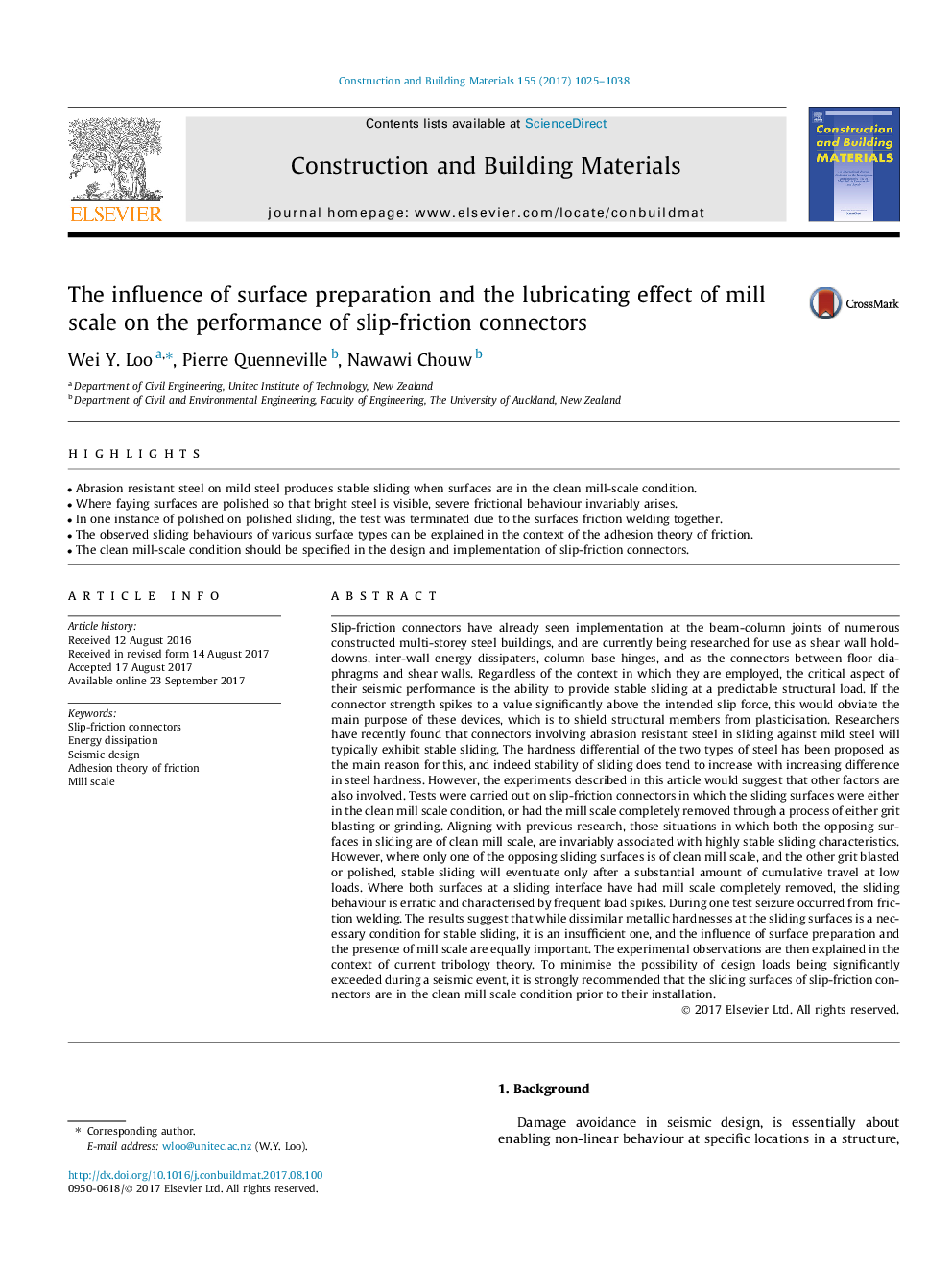| کد مقاله | کد نشریه | سال انتشار | مقاله انگلیسی | نسخه تمام متن |
|---|---|---|---|---|
| 4918142 | 1428751 | 2017 | 14 صفحه PDF | دانلود رایگان |
عنوان انگلیسی مقاله ISI
The influence of surface preparation and the lubricating effect of mill scale on the performance of slip-friction connectors
ترجمه فارسی عنوان
تاثیر آماده سازی سطح و تاثیر روانکاری مقیاس آسیاب بر عملکرد اتصالات اصطکاک لغزش
دانلود مقاله + سفارش ترجمه
دانلود مقاله ISI انگلیسی
رایگان برای ایرانیان
کلمات کلیدی
اتصالات اصطکاک لغزش، از بین بردن انرژی، طراحی لرزه ای، تئوری تطبیق اصطکاک، مقیاس میل،
ترجمه چکیده
اتصالات اصطکاک لغزش قبلا اجرا شده است در اتصالات پرتو ستون ساختمان های متعدد ساختمان ساخته شده از فولاد و در حال حاضر برای استفاده به عنوان نگه داشتن دیوار برشی، بینابزار های انرژی بین دیوار، پایه پایه ستون و به عنوان اتصالات بین دیافراگم های کف و دیوارهای برشی. صرف نظر از زمینه ای که در آن استخدام شده است، جنبه بحرانی عملکرد لرزه ای آنها توانایی ارائه کشش پایدار در یک بار ساختاری قابل پیش بینی است. اگر مقاومت اتصال به مقدار قابل توجهی بالاتر از نیروی لغزنده در نظر گرفته شده باشد، این امر هدف اصلی این دستگاه ها را از بین می برد، یعنی محافظت از قطعات ساختاری از پلاستیک سازی است. محققان به تازگی دریافته اند که اتصال دهنده های فولادی مقاوم در برابر سایش در کشش در برابر فولاد خفیف به طور معمول کشویی ثابت می کنند. دیفرانسیل سختی دو نوع فولاد به عنوان دلیل اصلی این پیشنهاد مطرح شده است و در واقع ثبات کشویی با افزایش تفاوت در سختی فولاد افزایش می یابد. با این حال، آزمایشات شرح داده شده در این مقاله نشان می دهد که عوامل دیگر نیز درگیر هستند. تست ها بر روی اتصالات لغزش اصطکاک انجام شد که در آن سطوح کششی یا در مقیاس مقیاس کارخانه تمیز، یا مقیاس کارخانه به طور کامل از طریق یک فرآیند یا شستشو شن یا سنگ زنی حذف شد. با توجه به تحقیقات قبلی، شرایطی که هر دو سطوح مخالف در کشویی از مقیاس کارخانه تمیز هستند، به طور پیوسته با ویژگی های کشویی بسیار پایدار همراه است. با این حال، در صورتی که فقط یک سطح کششی متضاد از مقیاس کارخانه تمیز باشد، و ساییدگی دیگر باریک یا جلا داده می شود، کشش پایدار تنها پس از مقدار قابل توجهی از سفر تجمعی در بارهای کم، رخ خواهد داد. از آنجا که هر دو سطح در یک رابط کشویی، مقیاس کارخانه به طور کامل برداشته شده است، رفتار کششی غیرمنتظره و مشخص شده توسط پشته بارگذاری مکرر است. در طی یک آزمایش تشنج از جوش اصطکاکی رخ داده است. نتایج نشان می دهد که در حالی که سختی های متالیکی فلز در سطوح کششی یک شرط لازم برای کشیدن پایدار است، این یک ناکافی است و تأثیر آماده سازی سطح و حضور مقیاس آسیاب نیز به همان اندازه مهم است. سپس مشاهدات تجربی در چارچوب نظریه فعلی اندیشه توضیح داده شده است. برای به حداکثر رساندن امکان بارگذاری طراحی در طول رخداد لرزه ای به طور قابل توجهی تجاوز می شود، به شدت توصیه می شود که سطوح کشویی اتصالات اصطکاک لغزش در شرایط مقیاس کارخانه تمیز قبل از نصب آنها باشد.
موضوعات مرتبط
مهندسی و علوم پایه
سایر رشته های مهندسی
مهندسی عمران و سازه
چکیده انگلیسی
Slip-friction connectors have already seen implementation at the beam-column joints of numerous constructed multi-storey steel buildings, and are currently being researched for use as shear wall hold-downs, inter-wall energy dissipaters, column base hinges, and as the connectors between floor diaphragms and shear walls. Regardless of the context in which they are employed, the critical aspect of their seismic performance is the ability to provide stable sliding at a predictable structural load. If the connector strength spikes to a value significantly above the intended slip force, this would obviate the main purpose of these devices, which is to shield structural members from plasticisation. Researchers have recently found that connectors involving abrasion resistant steel in sliding against mild steel will typically exhibit stable sliding. The hardness differential of the two types of steel has been proposed as the main reason for this, and indeed stability of sliding does tend to increase with increasing difference in steel hardness. However, the experiments described in this article would suggest that other factors are also involved. Tests were carried out on slip-friction connectors in which the sliding surfaces were either in the clean mill scale condition, or had the mill scale completely removed through a process of either grit blasting or grinding. Aligning with previous research, those situations in which both the opposing surfaces in sliding are of clean mill scale, are invariably associated with highly stable sliding characteristics. However, where only one of the opposing sliding surfaces is of clean mill scale, and the other grit blasted or polished, stable sliding will eventuate only after a substantial amount of cumulative travel at low loads. Where both surfaces at a sliding interface have had mill scale completely removed, the sliding behaviour is erratic and characterised by frequent load spikes. During one test seizure occurred from friction welding. The results suggest that while dissimilar metallic hardnesses at the sliding surfaces is a necessary condition for stable sliding, it is an insufficient one, and the influence of surface preparation and the presence of mill scale are equally important. The experimental observations are then explained in the context of current tribology theory. To minimise the possibility of design loads being significantly exceeded during a seismic event, it is strongly recommended that the sliding surfaces of slip-friction connectors are in the clean mill scale condition prior to their installation.
ناشر
Database: Elsevier - ScienceDirect (ساینس دایرکت)
Journal: Construction and Building Materials - Volume 155, 30 November 2017, Pages 1025-1038
Journal: Construction and Building Materials - Volume 155, 30 November 2017, Pages 1025-1038
نویسندگان
Wei Y. Loo, Pierre Quenneville, Nawawi Chouw,
